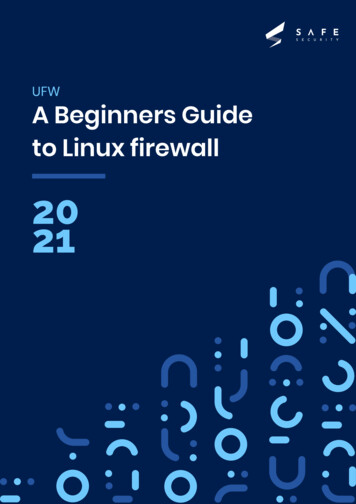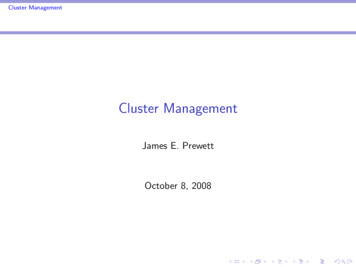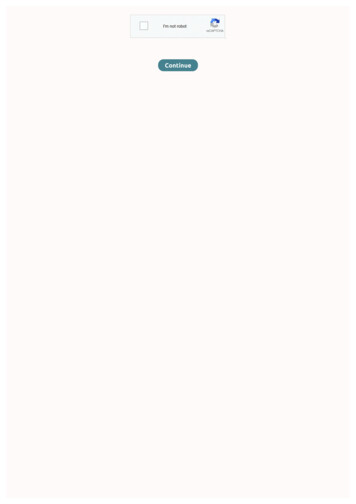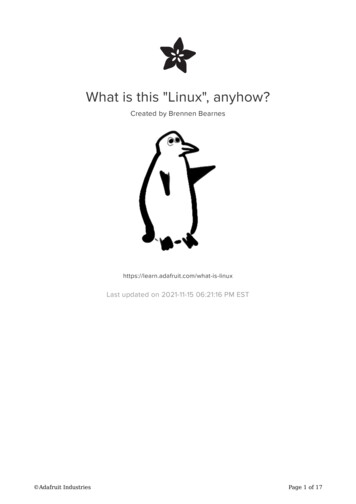
Transcription
UFWA Beginners Guideto Linux firewall2021
TABLE OFCONTENTSS afeSe c urity2 0 2 1Introduction01key Terms01Definitions01IP Tables & UFW02Getting Started02Basic Commands04Advanced Commands10Problems with firewall15Lab Exercise16R E S E A RC HP A P E R
IntroductionFIREWALLis the first line of defencefor any network, hence it isvery important to learnhow one can protect anetwork using a firewall.This document is intendedto provide detailed information about how UFWcan play a very importantrole for any Linux user interms of securing the Linuxsystem, this documentprovides all the informationnecessary to completelyconfigure UFW and protectpersonal Linux systemsfrom a variety of attacks.KEY TERMSBash, Netfilterqueue, IPtables, UFW (Uncomplicated Firewall), Virtual Machine.DEFINITIONSBashBash is a Unix shell written for the GNUProject as a free software replacement forthe Bourne shell (sh). It is often installed asthe system's default command-line interface. It provides end users an interface toissue system commands and executescripts.NetfilterNetfilter is a framework provided by theLinux kernel that allows various networking-related operations to be implementedin the form of customized handlers. Netfilteroffers various functions and operations forpacket filtering, network address translation, and port translation.IPtablesIptables is a user-space utility programthat allows a system administrator toconfigure the IP packet filter rules of theLinux kernel firewall, implemented asdifferent Netfilter modulesUFWUncomplicated Firewall (UFW) is a programfor managing a Netfilter firewall designedto be easy to use. It uses a command-lineinterface consisting of a small number ofsimple commands, and uses iptables forconfiguration.Virtual MachineA virtual machine is an emulation of acomputer system.S a feSe c urity2 0 2 1R E S E A RC HP A P E R01
IPTABLES AND UFW, WHAT’S THE DIFFERENCE?IPtables and UFW both are Linux system firewalls, the difference between them is UFW is builtupon IPtables, IPtables a very flexible tool but it’s more complex as compared to UFW, otherdifference is that IPtables requires a deeper understanding of TCP/IP, which might not be the casewith every Linux user, so UFW is the solution, UFW allows the user to configure firewall rules easilyusing IPtables. Hence, for an average Linux user UFW is the best way to get started with setting updifferent firewall rules.Easy to useUFWLess FlexibleComplex to useIPtablesMore flexibleGETTING STARTEDBefore we start writing different rules for the firewall, we need to have one, so let’s start by installing the firewall, since the system being used for purpose is Debian based, the command to installUFW is:apt-get install ufwOnce installed, it’s time to discover the tool itself, which can be done by writing:ufw --helpS afeSe c urity2 0 2 1R E S E A RC HP A P E R02
S a feSe c urity2 0 2 1R E S E A RC HP A P E R03
BASIC COMMANDSIt’s very important to get the basic commands right, once we know what thebasic commands are we’ll simply build upon them and then move to more advanced commands. To enable the UFW firewall we simply write the followingcommand.ufw enableUFW firewall, it comes with some default rules, these rules might be appropriate for some situations but not necessarily for every situation , so it’s best to configure the firewall from scratch.Let’s first view what the default rules are, to do that write following command:ufw status verboseThe primary focus here is to interpret what’s firewall is trying to tell us.A. Status:activeMeans firewall is activeB. Logging:on (low)Means logging is turned on and set to low level, log can be found in /var/logs/ufw.log }C. Default:allow (incoming)Means all the incoming connections are allowedallow (outgoing)Means all the outgoing connections are alloweddisabled (routed)Means port forwarding is disabled , basically no routingS afeSe c urity2 0 2 1R E S E A RC HP A P E R04
Changing Default RulesBefore changing the rules, it’s important to know what all operations are available to beperformed on the connection, UFW provides us four different options for the connections whichare:o Allow:Allow the connectiono Deny:Deny the connectiono Reject :Reject the connectiono LimitTo add rate limiting rules , using this rule will block an IP addresses if more thansix connections are instantiated within thirty seconds:Now there might be a confusion between Deny and Reject because they seem to be similar, thedifference between the two is when we use deny, it doesn’t tell the client what’s actually happening, but when we use reject, it actually tells the client that the connection is being rejected by theserver.The next step is to change few default rules, using below given commandufw default action flowTo change the default rule, specify the action (allow, deny etc.). After that, specify the flow ofconnection (incoming or outgoing). To deny all the outgoing connections, and to test it’s workingwrite following command:ufw default reject outgoingTo test it, go to the browser and search for anything.S a feSe c urity2 0 2 1R E S E A RC HP A P E R05
The website can’t have accessed, since all the outgoing connections are rejected by the firewall,in order to allow all the outgoing connections again update with following code:ufw default allow outgoingOnce this rule is set, one should be able to access the internet.This was just one example; where default rules are set for outgoing connections as well similarlyRules for ports and servicesOnce done with default rules, it’s time to get our hands on rules for different ports and services,syntax for defining rules for port and services isufw action flow port serviceA. Actionallow, deny, reject, limit.B. FlowHere we specify the flow of traffic, these rules will be applicable for in: for incoming, out: for outgoing)C. Port serviceEither specify port number or the service name (for example: for ssh we can write 22 or ssh)UFW supports multiple applications, we can view these applications by writing:ufw app listSupported Applications:AIMKTorrentNFSTelnetBonjourKerberos ahooDelugeMSNSMTPqBittorrentIMAPMail SubmissionSambaXMPPIPPS afeSe c uritySocks2 0 2 1R E S E A RC HP A P E R06
In case the application you are trying to use a firewall for, is not in the list of supported applications you can simply mention the port number your service is running on. So, for example if youwant to reject all the connections to your SSH serve, then write following command:ufw allow 22Or the service name if it’s present in the list.ufw allow sshIn the above example we did not mention the flow of traffic, by default the rules will be applied forthe incoming traffic, in order to apply rules for outgoing traffic, we explicitly need to mention theflow, for example:ufw allow out sshWhich tells the firewall to allow all the outgoing ssh connection.Similarly, we can write a firewall for telnet, since telnet is unencrypted we want to reject all theincoming telnet connections, so to do that we write:ufw reject in telnet comment “Telnet is unencrypted, rejecting connection! “Once we add the rule, we can view the firewall rules by writingufw statusWhich gives us something like this:Explanation:ToActionFromV6S a fe: The port number and the service: The action to be performed: Means connection from any IP: Rule for IPv6 versionSe c urity2 0 2 1R E S E A RC HP A P E R07
Command to delete rule:ufw status numberedOutput to above command:The command shows us the number for each rule, which allows us to specify a rule number anddelete it.So for instance if you want to delete the telent rule for IPv6 , then writeufw delete 2Once our command is executed, we can check the statusWhich confirms that we have successfully deleted the ruleNote: For each rule deleted, the rule number changes, for example if a rule is deleted with numberone, then the rule at number two will become the rule number one.
Rules for particular IP and SubnetsThere might be cases when we want to block a particular IP, this might be applicable when someparticular IP is trying to perform a brute force attack, or we might want to allow only particular IP’sto access the SSH server, use cases are many, different needs different use cases, so let’s learnhow can we write rule for particular IP or a whole subnet.Syntax:ufw action flow IP SubnetA. Actionaction to be performed (allow, deny, reject, limit)B. Flowincoming traffic or outgoing traffic (in, out)C. IP SubnetHere we can specify either an IP address or an entire subnet ( 192.168.10.204 or 192.168.12.2/24 )So for example, if we want to reject connections for a particular IP (let’s say 192.168.10.204) fromaccessing any port of our server, we can writeufw reject in from 192.168.10.204 comment “ Rejecting connections for 192.168.10.204 “On checking the statusS a feSe c urity2 0 2 1R E S E A RC HP A P E R08
Now any connection from 192.168.10.204 to any port will be rejected.In some cases, we might want to allow connections from a particular IP, for that we first need toreject all the incoming connections and then write a rule for the IP we want to allow connectionsfrom.ufw default reject incomingufw allow in from 192.168.10.208ufw status verboseOutput:S afeSe c urity2 0 2 1R E S E A RC HP A P E R09
ADVANCED COMMANDSWe have covered all the basic commands till now, but none of them seemsmuch practical, we want to do things like, restrict an IP only to a particular port,detect brute force and block the IP, restrict IP’s from accessing the ftp server butnot web server, all these things will be covered under this sections, we’ll writemore specific and meaningful rules, which we can actually implement in real life.Rules specific to IP’s and servicesBlocking an IP’s access to all the ports might not be something that everyone wants, people mightwant to restrict an IP from accessing let’s say any private service but not from the web server, insuch cases write rules where we specify the IP address and the port number or service name.ufw action flow from IP subnet to any port port.number serviceA. Actionaction to be performed (allow, deny, reject, limit)B. Flowincoming traffic or outgoing traffic (in, out)C. IP subnetspecifying the IP address or subnetD. Port.number servicespecifying the port number or service nameS a feSe c urity2 0 2 1ufw allow in from 192.168.10.207 toany port ssh comment "SSH allowed"R E S E A RC HP A P E R1 0
Example A:We want to write a rule which will allow only host 192.168.10.207 to access the SSH server, now tosolve this problem we need to do two things1. Block SSH service for all the IP addresses.2. Allow SSH service only for host 192.168.10.207ufw reject in sshufw allow in from 192.168.10.207 to any port ssh comment "SSH allowed"Output:Note: The sequence of rule matters in UFW, for example: if there’s a rule for blocking an IP address from accessing a webserver at position 2, but there’s another rule which allows access to web server at position 1, then the IP address will not beblocked, the firewall rules are applied in a sequence. We might need to add important rules at position 1, for that we useinsert 1.ufw insert 1 reject in from IP to any port port.number By specifying insert, this rule will be added at position 1.Example B:Let’s suppose we need to reject any UDP connection from an IP address (192.168.10.207)ufw reject in from 192.168.10.207 to any proto udpProto is used to specify the transmission protocol (TCP or UDP).Similarly, we can write rules for other services and protocols depending upon the usability.S afeSe c urity2 0 2 1R E S E A RC HP A P E R1 1
Writing rules for specific interfacesThere might be some cases where, the user wants to allow access to a particular service from aparticular subnet, in such cases UFW allows us to set up interface dependent rulesExample:Allow access to ssh server to all the IP addresses on network interface eth0.To make sure that other IP addresses are not able to access the service on port 22ufw reject in sshAnother rule to allow ssh access to all the IP addresses on interface eth0ufw allow in on eth0 to any port 22Logging RulesWhen we talk about logging information about connections, it’s a very important concept tounderstand the type of incoming connections, logging information about incoming/outgoingconnections can help a system administrator, to trace back any attack to its source, logs alsohelp system administrator to check if all the firewall rules are working properly or not.UFW provides us the ability to log, in addition to that it also provides different logging levelsdepending on the need, logging in UFW is enabled by default at low level. To see the logging level,we can writeufw status verboseS a feSe c urity2 0 2 1R E S E A RC HP A P E R1 2
We can see that logging is on and is set to low level.UFW provides four logging levels:A. Low:a. Logs blocked packets (with rate limiting)b. Logs packet matching logged rulesB. Medium:a.b.c.d.Logs Low level logsLogs all allowed packets not matching with policyLogs all invalid packetsLogs all new connections (all the logging is done with rate limiting)C. High:a. Logs medium level without rate limitingb. Logs all the other packets with rate limitingD. Full:a. Logs high level without rate limitingTo change the log levels or to turn it off or on, we write:ufw logging optionOption can have any of the following values1. On2. Off3. Low4. Medium5. High6. FullSo for example: UFW logging if off by default in my system and you need to turn it on at mediumlevel, so command is as follow:ufw logging mediumS afeSe c urity2 0 2 1R E S E A RC HP A P E R1 3
Reading logsReading logs is very important as we have discussed earlier, they help us to detect any threat,test our firewall and other important tasks.Logs for UFW are stored in file /var/logs/ufw.logOct 31 16:29:53 FRIEND kernel: [ 3253.426605] [UFW BLOCK] IN OUT eth0 SRC SIP DST DIPLEN 73 TOS 0x00 PREC 0x00 TTL 64 ID 61481 DF PROTO UDP SPT 45316 DPT 53 LEN 53Here we have one of the many logs from ufw.log file, so let’s break it down and understand whatexactly does it mean1. IN: If this contains a value means the event was incoming2. OUT: If this contains a value means the event was outgoing (interface specified)3. SRC: Source IP address4. DST: Destination IP address5. LEN: Packet length6. TTL: Time to lives7. PROTO : Packet’s protocol8. SPT: Source port9. DPT: Destination port10. WINDOW: The packet size , that sender can receive ( not present in the above example ,since it’s a low level log )S a feSe c urity2 0 2 1R E S E A RC HP A P E R1 4
PROBLEMS WITH FIREWALLEven though firewalls are first line of defence, but they can’t protect us againstevery type of attack, there are certain places where firewall lack, things like1. A firewall cannot protect against internal network attacks.2. They do not protect us against backdoor attack.3. Firewalls cannot protect a network or pc from viruses, Trojans, worms and spyware whichspread through flash drives, potable hard disk and floppy etc.4. Firewalls cannot protect against IP spoofingAs we already know that firewall do have their own weaknesses, but that doesn’tmean they are of no importance, a firewall should definitely be a part of defencebut it shouldn't be the only part, we should never rely on just firewalls, other software’s like IDS (intrusion detection system) and IPS (intrusion prevention system),should be used in combination with firewall.S afeSe c urity2 0 2 1R E S E A RC HP A P E R1 5
LAB EXERCISEAim:To implement whatever, learnt so far almost everything.Prerequisites1. A host machine with VMware or Virtual Box installed.2. Kali Linux as virtual machine.3. Internet Connection.Recommendations1. Configure and run Apache2 server on Kali Linux machine.2. Configure and run SSH on Kali Linux machine.Procedure1. So the Kali machine is the machine, run UFW on and our host machine is our client machine.2. The task is to write different rules based upon the tasks which are given.3. Make sure that both apache2 and ssh services are running.Tasks1. Write a rule to change the ufw default settings for outgoing connections to reject.2. Write a rule to block all the incoming connections and see if you are able to connect or not.3. Write a rule to block the host machine from accessing ssh service but not web server.4. Write a rule which will protect against brute force attacks.5. Write a rule to block all the UDP connections from host IP.6. Write a rule to log in high mode and read the logs generated.7. Write a rule to allow access to web server only from a particular host.8. What are some disadvantages of firewall?9. Write a rule with action as deny and another rule with action as reject, analyse the difference betweenboth.S a feSe c urity2 0 2 1R E S E A RC HP A P E R1 6
fw/https://youtu.be/-CzvPjZ9hp8www.safe.security info@safe.securityStandford Research Park,3260 Hillview Avenue,Palo Alto, CA - 94304
with every Linux user, so UFW is the solution, UFW allows the user to configure firewall rules easily using IPtables. Hence, for an average Linux user UFW is the best way to get started with setting up different firewall rules. Before we start writing different rules for the firewall, we need to have one, so let's start by install-











